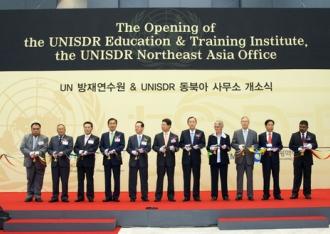Incheon, Korea- An Integrated Assessment Tool for Local Governments

UNISDR's Office for Northeast Asia and Global Education Training Institute (UNISDR ONEA-GETI) © UNISDR
Assessing disaster management and safety was not a new undertaking in Korea. The country had its own national evaluation framework and had been carrying out annual assessments since 2005. Based on the evaluations, local governments were able to recognise their strengths and weaknesses with regard to disaster risk reduction and acknowledge the importance of taking proactive measures to improve the challenges they face. However, once Korea began to actively encourage local governments to join the Making Cities Resilient Campaign, a new opportunity came to light.
One objective of the Campaign is to help local governments analyse their DRR systems and build strong capacity. The Local Government Self-Assessment Tool (LGSAT) is key to this process. Yet Korea already had an assessment framework in place. Would local governments be unduly burdened by having to implement the LGSAT as well? To avoid this, the National Emergency Management Agency (NEMA) partnered with the UNISDR Global Education and Training Institute (GETI) in Incheon to harmonise the two evaluation frameworks. A task force was charged with analysing similarities and overlapping elements between the two methods and integrating them into a single DRR assessment tool, which local governments could easily adopt. As a result, the assessment items from the LGSAT were integrated with the indicators in the existing evaluation system to create a new national LGSAT, tailored to Korea.
NEMA is providing additional incentives to city governments that join the Making Cities Resilient Campaign. They will receive support for implementing the Korean LGSAT for a period of three years and those selected as ‘champions,’ at the end of this period, will be acknowledged with certification as a ‘Disaster-Safe City,’ awarded by NEMA and UNISDR. To date, 108 local governments have joined the Campaign.
To know more about GETI please see: http://www.unisdr.org/incheon/about
UNISDR's 'Making Cities Resilient Campaign'
UNISDR launched the Making Cities Resilient Campaign in 2010 which has developed a global network of more than 2,500 local governments committed to reducing risk and building more resilient cities. These local governments represent cities of different sizes, characteristics, risk profiles and locations. Their efforts are reinforced by a supportive group of partner organizations.
The Campaign’s focus is on disaster resilience – that is, the ability of a city to plan for, mitigate, respond, recover, adapt and grow after major in the light of its unique physical, economic, environmental and social circumstances. On a spectrum ranging from chronic stresses (environmental, social or economic imbalances) through to acute stresses, disasters are at the acute pole, but may be exacerbated by a background of chronic stress – where for example upstream deforestation increases the propensity for as hooding, or where economic imbalances hinder the recovery process.
“It is clear that the risk in cities is growing faster than our ability to reduce them. We need to innovate and ensure that solutions, tools and methods for resilience building are not only available, but also accessible. We need to accelerate resilience building at the local level, and this partnership will contribute to do this.”
- Margareta Wahlström at the Third UN Conference on Disaster Risk Reduction in Sendai, Japan in March, 2015.
